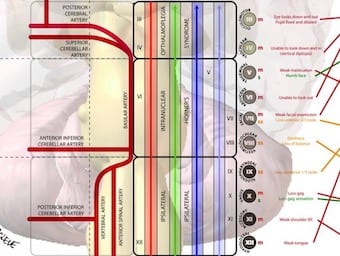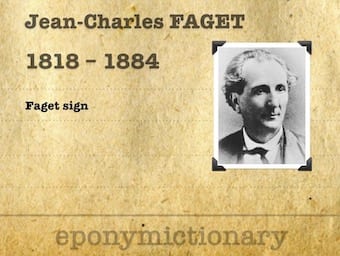
Helpful Brainstem Figures
Helpful Brainstem Figures. Cross-sections of the brainstem. Medial brainstem syndromes and lateral brainstem syndromes

Helpful Brainstem Figures. Cross-sections of the brainstem. Medial brainstem syndromes and lateral brainstem syndromes

Biography Born 2 February 1833, Ronsdorf Died 24 November 1901, Tübingen Medical Eponyms Liebermeister rule: Defining the relationship between pulse frequency and body temperature in fever. In fever, when the body temperature increases by one degree centigrade, the pulse frequency…

Faget Sign: Relative bradycardia in association with fever (Temperature-pulse dissociation). Originally described by Jean-Charles Faget in patients with yellow fever (1859)

Liebermeister rule: Defining the relationship between pulse frequency and body temperature in fever. Carl von Liebermeister (1833 - 1901)

Jean-Charles Faget (1818 - 1884) was a French physician. Faget reported an exception to the Liebermeister rule in his description of yellow fever [Faget sign] in 1858

Peter Gates rule of 4 of the brainstem illustrated in a single diagram...why and how?

Gates described a simplified method for answering the question 'Where is the lesion?' using only the parts of the brainstem that we actually examine during a clinical examination to understand brainstem vascular syndromes.

When you travel from Perth in Western Australia to San Francisco you are in for a long day...a forty hour day in fact, thanks to the arbitrary placement of the international dateline. I am here to meet emergency medicine edumactor extraordinaire Mel Herbert at the USC Essentials of Emergency Medicine extravaganza...

David Bayford (1739 – 1790) was an English surgeon and physician. In February I76I, Bayford (1739-1790) was present for an autopsy where an emaciated woman (Jane Fordham) of 62 died of ‘obstructed deglutition’ of many years standing. Dr Lucas performing…

Adolphe-Marie Gubler (1821-1879) was a French physician and therapeutic pharmacologist. Millard-Gubler syndrome (1856)

Peyronie disease refers to plaques (flat scar tissue) forming under the skin of the penis. The plaques can be palpated through the skin; are often painful; and can cause the penis to bend, shorten or become indented during erections.

Charles Clifford Macklin (1883-1959) was a Canadian pulmonologist. Macklin Effect (1939)